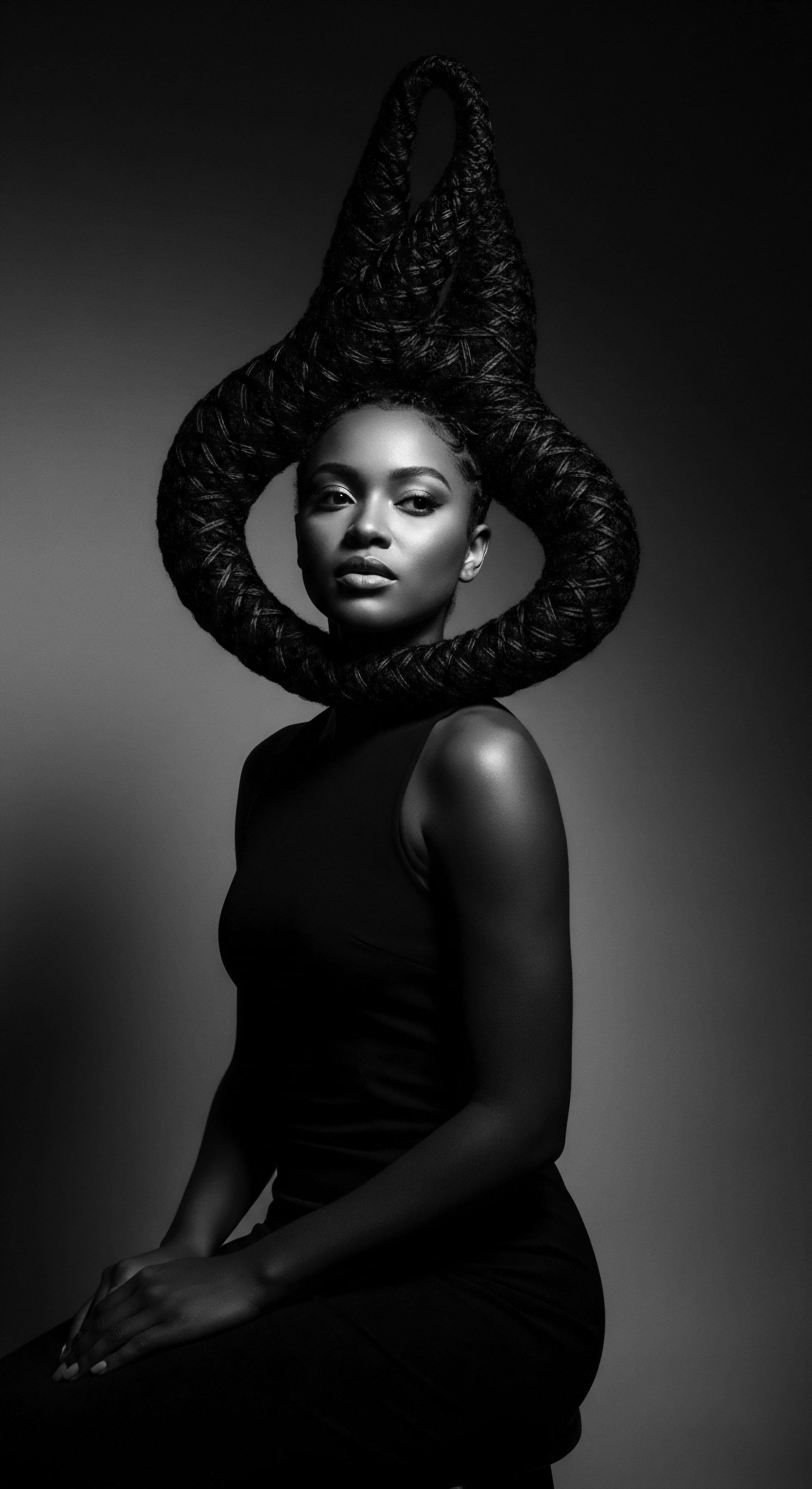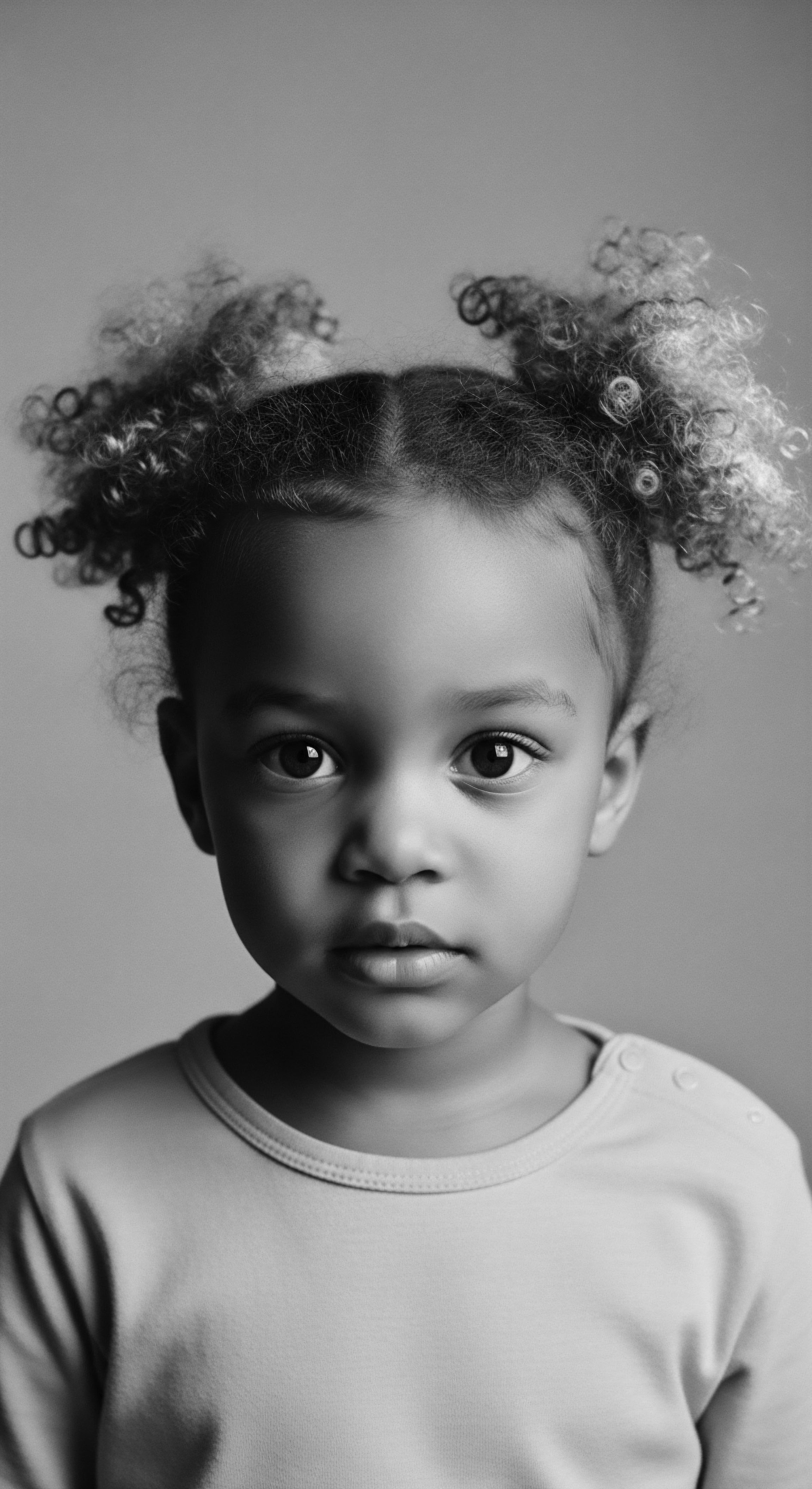
Fundamentals
The journey of each strand upon our heads, a testament to life’s unfolding, holds stories etched not only by time’s passage but by the very whispers of our ancestral codes. To speak of Genetic Hair Graying is to embark upon a path that intertwines the elemental biology of human hair with the profound cultural tapestries woven by generations. At its simplest, this phenomenon, this turning of hair from its vibrant birth hue to shades of silver, ash, and pure white, denotes a gradual cessation of pigment production within the hair follicles.
Imagine the hair follicle, a microscopic dwelling nestled beneath the skin’s surface, as a sacred artisan. Within this tiny workshop reside specialized cells, the Melanocytes, charged with crafting the pigments that bestow upon each hair its distinctive shade. These pigments, primarily two forms of melanin—Eumelanin, responsible for browns and blacks, and Pheomelanin, lending its warmth to reds and yellows—are diligently deposited into the growing hair shaft. As the hair ascends from the scalp, it carries this genetic palette, reflecting the unique heritage passed down through countless forebears.
The process of graying, often beginning subtly, is a natural part of the human experience, a visible chronicle of years lived and wisdom gathered. Each hair follicle possesses its own biological clock, dictating the lifespan and activity of its melanocytes. When these cellular artisans begin to wane, diminishing their output of melanin, the hair shaft itself is no longer infused with color.
This results in the appearance of individual gray strands, which, when numerous, create the collective perception of a graying head of hair. It is not that the hair itself changes color; rather, the subsequent hairs produced by those specific follicles emerge devoid of pigment, inheriting only the natural, translucent quality of keratin.
Genetic Hair Graying signifies the gentle, natural cessation of pigment production within hair follicles, a visible chronicle of life’s journey and inherited legacy.
This elemental explanation provides a foundational understanding, yet it merely scratches the surface of its deeper meaning. For those of us with textured hair, particularly within Black and mixed-race communities, the appearance of gray strands carries layers of historical resonance and cultural significance. It is a sign that speaks not just of age, but of resilience, of stories lived, and of the enduring spirit passed down through generations.

Intermediate
Moving beyond the foundational understanding, the intricate ballet of molecular processes choreographs the appearance of graying hair, a dance deeply rooted in our inherited predispositions and ancestral lineage. At the heart of this transformation lies the Melanogenesis Pathway, the biochemical symphony responsible for melanin synthesis. Melanocytes, the pigment-producing cells within the hair follicle, orchestrate this process.
Over time, their activity diminishes, leading to the gradual reduction and eventual cessation of melanin delivery to the hair shaft. This physiological shift forms the biological bedrock of Genetic Hair Graying.
The dwindling of melanocyte function is intricately linked to several biological factors. One such factor is the increasing susceptibility of these cells to Oxidative Stress. As years accumulate, the hair follicle, like other bodily systems, can experience an accumulation of reactive oxygen species.
These molecules, if not adequately neutralized by antioxidant defenses, can damage melanocytes, impairing their ability to produce pigment and even leading to their demise. This delicate balance between oxidative processes and cellular protection plays a significant role in the timing and progression of graying.
Genetics, a vast and ancient library within our very being, dictates the timing of this pigment decline. It’s why some individuals behold their first silver threads in their youth, while others may experience a later onset. Research consistently points to a clear distinction in the average age of graying onset across diverse populations, a truth that underscores the unique journey of each hair type.
For instance, studies have indicated that the average age for the onset of gray hair in people of African ethnicity is in their Mid-Forties, a notable contrast to those of Caucasian descent, who often experience graying beginning in their mid-thirties, and Asian individuals, whose hair may begin to silver in their late thirties. This biological distinction in timing hints at a deeper genetic heritage at play.
The genetic blueprint guides the onset of graying, with individuals of African descent often experiencing the appearance of silver strands later in life compared to other populations.
This delayed onset in individuals of African ancestry is attributed, in part, to specific characteristics of their hair. African hair samples have been found to possess Larger Melanosome Sizes and a Higher Melanosome Density compared to hair samples from Caucasian or Asian individuals. These melanosomes, the tiny organelles within melanocytes that store and transport melanin, act as more robust pigment repositories.
Their enhanced size and concentration may provide a protective buffer, allowing for a longer period of vibrant color production before the inherent cellular aging processes lead to a visible loss of pigment. This natural endowment is a testament to the ancestral resilience embodied in textured hair.
Understanding these intermediate mechanisms deepens our appreciation for the intrinsic differences that shape our hair’s journey. It moves beyond a mere observation of color change, inviting us to consider the profound interplay of inherited biology and environmental factors that contribute to the unique manifestations of graying across the human family. For those of us connected to textured hair legacies, this scientific lens offers a validation of the inherent strength and distinctive qualities of our hair, affirming a narrative that runs parallel to the cultural stories of wisdom and veneration associated with silvered strands.
Beyond the biological framework, the societal perception of graying in textured hair has its own history. While Western beauty standards have frequently promoted the concealment of gray hair, often equating it with aging and a departure from perceived youth, many African societies have historically bestowed reverence upon silvered crowns. This reverence links the appearance of graying hair directly to the acquisition of wisdom, experience, and esteemed status within the community. The shift from dark hues to lighter tones became a visual marker of one’s journey through life, gaining knowledge and standing as an elder.

Academic
The academic elucidation of Genetic Hair Graying transcends a simple observation of pigment loss, delving into the intricate molecular and cellular mechanisms that dictate the precise timing and pattern of this universal physiological alteration. This phenomenon, known scientifically as Canities, is understood as a genetically programmed reduction, and subsequent cessation, of melanin synthesis within the hair follicular melanogenesis unit. This precise interpretation clarifies that graying represents not a disorder, but a complex, inherited biological clock governing melanocyte activity and survival.
The biological basis of canities hinges on the gradual decline and eventual apoptosis, or programmed cell death, of follicular Melanocytes—the highly specialized cells responsible for producing the melanin pigments. These cells, originating from the neural crest, migrate into the hair bulb during embryogenesis and maintain their pigmentary function throughout successive hair cycles. A critical aspect of this decline involves the accumulation of Hydrogen Peroxide (H₂O₂) within the hair follicle. Normal metabolic processes generate H₂O₂, which is typically neutralized by the enzyme Catalase.
With advancing age, a decrease in catalase activity, coupled with a decline in other antioxidant enzymes such as TRP-1 and TRP-2, leads to an excessive buildup of H₂O₂. This oxidative burden specifically targets and damages melanocytes, interfering with the enzyme tyrosinase, which is indispensable for melanin production. Consequently, new hair fibers emerge devoid of pigment, appearing white or silver due to the optical properties of unpigmented keratin.
The genetic predisposition to graying is a topic of intense study, with numerous genetic loci implicated in influencing both the onset and progression of canities. The most extensively researched genetic factor linked to hair color and graying is the MC1R (Melanocortin 1 Receptor) Gene. This gene plays a critical part in determining the balance between eumelanin and pheomelanin production.
Variations within the MC1R gene, alongside other candidate genes such as IRF4 (Interferon Regulatory Factor 4) and PAX3 (Paired Box 3), contribute to the significant inter-individual variability observed in the graying process across diverse human populations. Such genetic influences underscore that the temporal expression of graying is not arbitrary, but rather a carefully orchestrated genetic narrative embedded within our very being.
Canities, or genetic hair graying, is a precise biological process of pigment cessation, governed by complex molecular mechanisms and deeply influenced by inherited genetic predispositions.
From an academic vantage point, the study of genetic hair graying within the context of textured hair, particularly that of individuals of Black and mixed-race heritage, offers profound insights. Beyond the universal biological mechanisms, the genetic characteristics of African hair types present a fascinating dimension. As previously noted, the average onset of graying in individuals of African ethnicity tends to occur later, typically in their mid-forties, contrasting with the mid-thirties for Caucasians. This intriguing observation is not merely a statistical anomaly; it is supported by structural differences at the microscopic level.
Research indicates that hair samples from individuals of African ancestry exhibit Larger Melanosome Sizes and a Higher Density of Melanosomes within their hair follicles when compared to those of Caucasian or Asian origin. Melanosomes, acting as cellular melanin reservoirs, likely provide a more robust and resilient pigmentary system. This increased capacity for melanin storage and delivery may confer a delayed susceptibility to the oxidative stress and melanocyte senescence that precipitate graying.
This biological distinction, intricately linked to millennia of evolutionary adaptation, forms a compelling narrative that connects elemental biology with the lived experience of diverse hair heritage. The inherent qualities of highly pigmented, textured hair types appear to offer a natural buffer against the early advent of pigment loss, making the appearance of graying a true marker of a life fully lived, rather than an early sign of decline.
The cultural reception and significance of gray hair within Black and mixed-race communities present a counter-narrative to Western aesthetic ideals that often stigmatize graying. Historically, in many African societies, gray hair was not merely accepted but deeply revered. It symbolized accumulated Wisdom, profound experience, and a revered connection to ancestral knowledge.
Elders, often identified by their silvered crowns, held positions of immense respect and authority, embodying the collective memory and spiritual guidance of their communities. Their hair was considered a physical manifestation of their spiritual power and societal standing.
This cultural veneration stands in stark contrast to the narratives imposed during and after the transatlantic slave trade and colonialism. During these periods, deliberate efforts were made to strip Africans of their identity, including the forceful shaving of hair—a practice deeply dehumanizing given hair’s symbolic value in pre-colonial African societies where hairstyles conveyed social status, age, wealth, and tribal affiliation. The prevailing Eurocentric beauty standards often devalued natural textured hair, labeling it as “unprofessional” or “unruly,” pushing many to chemically alter their hair to conform. This historical pressure created a complex relationship with natural hair, including graying hair.
However, the enduring legacy of ancestral wisdom has continued to shape perspectives. The recent resurgence of the natural hair movement in the diaspora serves as a powerful reclamation of inherent beauty and cultural heritage. This movement champions the acceptance of natural textures and, increasingly, embraces graying hair as a sign of authenticity and inner strength.
It is a deliberate rejection of imposed beauty norms, reaffirming the deep connection to ancestral practices that once celebrated every strand as a badge of honor. The wisdom passed down through generations, often through hair grooming rituals that were communal and bonding activities, reminds us that the journey of graying hair is a part of a larger, sacred narrative of self and collective identity.

Cultural and Historical Contexts of Hair Graying
Across the African continent, and among its descendants in the diaspora, hair has always been a profound repository of meaning. Before the pervasive influence of colonial aesthetics, hair communicated volumes about an individual’s life. A person’s hairstyle or the state of their hair could denote their marital status, their age, their lineage, their religious affiliation, or their standing within a community. Graying hair, therefore, became a visible signifier of elderhood, a mark of having traversed many seasons, accumulating knowledge and experience along the way.
- Ancestral Wisdom ❉ In many traditional African cultures, silvered strands were seen as pathways to the divine, a physical manifestation of spiritual insight and connection to ancestors. Such reverence fostered an environment where graying was not a cosmetic concern but a badge of honor.
- Community Standing ❉ The appearance of gray hair often coincided with elevated roles within the community, such as becoming a respected elder, storyteller, or spiritual guide. This social elevation solidified the positive perception of graying.
- Traditional Practices ❉ While external pressures later pushed for concealment, ancestral hair care practices focused on nourishing the hair and scalp, honoring its natural state, rather than altering its inherent color. Natural ingredients and communal grooming rituals nurtured the hair’s lifecycle, including its graying transition.

Societal Shifts and Reclamation
The historical rupture of slavery and colonialism significantly distorted the indigenous valuing of Black hair, including the perception of graying. The forced shaving of heads during enslavement was a deliberate act of cultural eradication, aiming to sever ties to identity and heritage. In the centuries that followed, the dominant Eurocentric beauty standards propagated the idea that straight, dark hair was the epitome of beauty, leading to widespread practices of straightening and chemically altering textured hair, often at great cost to hair health and cultural pride. Even graying hair, once revered, often became a feature to be hidden or dyed.
Yet, the spirit of resilience among Black and mixed-race communities could not be extinguished. The natural hair movement, gaining momentum in the 20th and 21st centuries, represents a powerful act of self-determination and cultural reclamation. It challenges antiquated beauty norms, advocating for the celebration of every curl, coil, and strand in its authentic state, including silvered wisdom highlights. This movement acknowledges the profound connection between hair, identity, and ancestral heritage, creating spaces where graying hair is seen not as a deficit, but as a continuation of a dignified legacy.
| Aspect Symbolism of Gray Hair |
| Ancestral & Pre-Colonial View Wisdom, reverence, elderhood, spiritual connection, accumulated experience. |
| Post-Colonial & Eurocentric Influence Sign of aging, often associated with decline, something to be concealed. |
| Contemporary Reclamation & Heritage-Focused View Authenticity, resilience, natural beauty, ancestral connection, personal journey. |
| Aspect Hair Care Practices |
| Ancestral & Pre-Colonial View Nourishment with natural butters, herbs, communal grooming; honor natural state. |
| Post-Colonial & Eurocentric Influence Chemical straightening, dyes for concealment, assimilation to Western standards. |
| Contemporary Reclamation & Heritage-Focused View Emphasis on natural textures, scalp health, herbal treatments, celebrating inherent qualities. |
| Aspect Societal Acceptance |
| Ancestral & Pre-Colonial View Highly valued, respected, often marking elevated status within communities. |
| Post-Colonial & Eurocentric Influence Stigmatized, seen as unprofessional or unattractive in formal settings. |
| Contemporary Reclamation & Heritage-Focused View Growing acceptance, legal protections (CROWN Act), celebrated in diverse media. |
| Aspect This table reveals the enduring journey of valuing gray hair within Black and mixed-race heritage, a testament to cultural resilience. |
The academic lens, therefore, allows for a multi-layered comprehension of Genetic Hair Graying. It is a biological process influenced by genetics and oxidative stress, a physiological truth that notably manifests later in individuals of African ancestry due to intrinsic hair characteristics. More profoundly, it is a marker imbued with profound cultural meaning, a silent language spoken through the strands, echoing histories of reverence, resistance, and reclamation within the vibrant tapestry of Black and mixed-race hair heritage. The ongoing dialogue between scientific discovery and ancestral knowledge continues to deepen our respect for the complexities of hair and its integral place in identity.

Reflection on the Heritage of Genetic Hair Graying
As we stand at the nexus of scientific understanding and ancestral wisdom, the journey through the definition of Genetic Hair Graying becomes a profound meditation on the enduring spirit of textured hair. It is more than a biological phenomenon; it is a living archive, each silvered strand a whisper from generations past, carrying forth stories of resilience, knowledge, and an unwavering connection to heritage. The wisdom lines that appear in our crowns, whether they arrive in our youth or later in life, remind us of a sacred lineage, a journey that began with the very first melanocytes shaping the hues of our earliest forebears.
The knowledge that textured hair, particularly that of African ancestry, often carries a genetic predisposition for a later onset of graying, rooted in the very structure and density of its pigmentary units, offers a scientific validation to the deep-seated reverence for silvered crowns in traditional African cultures. This inherent quality, this biological inclination towards sustained vibrancy, echoes the ancient esteem for elders, their graying hair a literal badge of enduring life, lived wisdom, and spiritual closeness. It speaks to a heritage where age was not a diminishing but an accumulating force, each year adding to the richness of one’s being, visibly stamped upon the very strands.
Yet, this journey also acknowledges the shadows of historical pressures, the colonial gaze that sought to diminish the profound beauty of natural textures and the natural progression of graying. The cultural memory of forced conformity and the erasure of traditional hair practices linger, a reminder of the battles fought for the right to embody one’s authentic self. However, the reclamation of natural hair, a powerful tide flowing across the diaspora, signals a return to source, a conscious decision to honor the blueprint of our ancestors. It is a heartfelt acceptance of every coil, every kink, and indeed, every silver strand, as an intrinsic part of a beautiful, unyielding identity.
The presence of silvered strands on textured hair signifies a profound connection to ancestral wisdom and a resilient journey through time.
In this light, Genetic Hair Graying within the context of textured hair ceases to be merely a biological footnote. It transforms into a narrative of continuity, a visible thread connecting the past, present, and future. It invites us to look upon silvered hair not as a sign of fading, but as a sign of unfolding, a testament to the life force that courses through our ancestral lines.
It is a call to cherish the wisdom highlights, to listen to the silent stories they tell, and to walk forward with a profound appreciation for the heritage woven into every single strand. The essence of this understanding lies in recognizing that our hair, in all its forms and all its changes, remains our crown, a vibrant symbol of our indelible legacy and the endless possibilities that lie ahead.

References
- Banks, I. (2000). Hair Matters ❉ Beauty, Power, and Black Women’s Consciousness. New York University Press.
- Byrd, A. & Tharps, L. D. (2001). Hair Story ❉ Untangling the Roots of Black Hair in America. St. Martin’s Press.
- Chapman, B. (2014). Examining the Experiences of Black Women with Natural Hair. CUNY Academic Works.
- Jacobs-Huey, L. (2006). From the Kitchen to the Salon ❉ Language and Cultural Co-Construction in an African American Community. Oxford University Press.
- Johnson, S. L. & Bankhead, A. (2014). Hair and Identity ❉ The Story of African American Women’s Hair. Journal of Black Studies.
- Maymone, M. B. C. et al. (2021). Hair Aging in Different Races and Ethnicities. The Journal of Clinical and Aesthetic Dermatology, 14(1), 32–37.
- Rooks, N. M. (1996). Hair Raising ❉ Beauty, Culture, and African American Women. Rutgers University Press.
- Shahin, C. (2021). Natural Hair Coloring. Hachette Book Group.
- Tate, S. (2007). Black Beauty ❉ Aesthetics, Culture, and Identity. Ashgate Publishing.
- Thompson, E. (2009). Hair Power ❉ African American Hair and Its Place in Culture. University of Texas Press.
